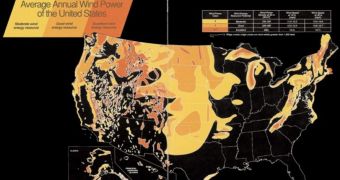A new investigation conducted by the National Renewable Energy Laboratory (NREL), and the consulting firm AWS Truewind, has determined that the potential the United States have of using wind as a source of alternative energy is in fact three times higher than initial estimates predicted. Taking into account only areas that are not part of environmental protection programs, the study showed that the rest of the land could be used to produce up to 37,000,000 gigawatt-hours of electricity per year, which is a considerable amount of energy.
The previous estimate was conducted in 1993, by experts at the US Department of Energy' Pacific Northwest National Laboratory (PNNL). That document showed that the maximum amount achievable in the US was of around 10,777,000 gigawatt-hours. The new paper enhances these figures almost three-fold, providing extra incentives for investors to start placing money in the new technologies. But analysts say that the difference is not really that important. At this point, the Untied States consume about 3,000,000 gigawatt-hours of electricity per year, according to statistics from 2008. Therefore, either of the estimates would cover the demands several times over, Wired reports.
The NREL/AWS team says that the new numbers are not bigger because scientists managed to assess the potential of the US wind landscape better, but because significant advancements have been made in wind turbine technologies over the past 17 years. Modern wind turbines are more powerful, larger, taller and more efficient than their older counterparts, and this increase in their ability to convert wind to electricity is mainly to be held responsible for the large differences in numbers. “Now we can develop areas that in [previous decades] wouldn’t have been deemed developable. It’s like oil reserves. They tend to go up not because there is more oil in the ground but because the technology for accessing the oil gets better,” AWS' Chief Technology Officer, Michael Brower, says.
The investigators hope that the new estimates they've presented will make it a lot easier for investors, constructors and wind companies to plan for, develop and then operate more advanced wind farms. “I think of it more as greasing the wheels of the process more than producing a really big cost savings. You reduce the friction, the transaction costs, and that enables you to get where you’re going faster,” the AWS officer adds. At this point, thanks to improvements brought to the national wind farms, the United States are capable of generating 35 gigawatts from this renewable resource.

 14 DAY TRIAL //
14 DAY TRIAL //